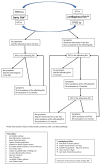Alternative Fish Species for Nutritional Management of Children with Fish-FPIES-A Clinical Approach
- PMID: 35010894
- PMCID: PMC8746553
- DOI: 10.3390/nu14010019
Alternative Fish Species for Nutritional Management of Children with Fish-FPIES-A Clinical Approach
Abstract
In the Mediterranean region, fish is a common cause of food protein-induced enterocolitis syndrome (FPIES) in children. No laboratory tests specific to FPIES are available, and oral food challenge (OFC) is the gold standard for its diagnosis and testing for achievement of tolerance. Children with FPIES to fish are usually advised to avoid all fish, regardless of the species. Fish are typically classified into bony and cartilaginous, which are phylogenetically distant species and therefore contain less cross-reacting allergens. The protein β-parvalbumin, considered a pan-allergenic, is found in bony fish, while the non-allergenic α-parvalbumin is commonly found in cartilaginous fish. Based on this difference, as a first step in the therapeutic process of children with FPIES caused by a certain fish in the bony fish category (i.e., hake, cod, perch, sardine, gilthead sea bream, red mullet, sole, megrim, sea bass, anchovy, tuna, swordfish, trout, etc.), an OFC to an alternative from the category of cartilaginous fish is suggested (i.e., blue shark, tope shark, dogfish, monkfish, skate, and ray) and vice versa. Regarding the increased mercury content in some sharks and other large species, the maximum limit imposed by the European Food Safety Authority (EFSA) for weekly mercury intake must be considered. An algorithm for the management of fish-FPIES, including alternative fish species, is proposed.
Keywords: bony fish; cartilaginous fish; fish; food protein-induced enterocolitis syndrome (FPIES).
Conflict of interest statement
The authors declare no conflict of interest.
Figures

References
-
- Sopo S.M., Giorgio V., Dello Iacono I., Novembre E., Mori F., Onesimo R. A multicentre retrospective study of 66 Italian children with food protein-induced enterocolitis syndrome: Different management for different phenotypes. Clin. Exp. Allergy. 2012;42:1257–1265. doi: 10.1111/j.1365-2222.2012.04027.x. - DOI - PubMed
-
- Vila L., García V., Rial M.J., Novoa E., Cacharron T. Fish is a major trigger of solid food protein–induced enterocolitis syndrome in Spanish children. [(accessed on 1 November 2021)];J. Allergy Clin. Immunol. Pract. 2015 3:621–623. doi: 10.1016/j.jaip.2015.03.006. Available online: https://www.ncbi.nlm.nih.gov/pubmed/25869583. - DOI - PubMed
-
- Vazquez-Ortiz M., Machinena A., Dominguez O., Alvaro M., Calvo-Campoverde K., Giner M.T., Jiménez-Feijoo R., Lozano J., Piquer M., Dias M., et al. Food protein–induced enterocolitis syndrome to fish and egg usually resolves by age 5 years in Spanish children. [(accessed on 1 November 2021)];J. Allergy Clin. Immunol. Pract. 2017 5:512–515.e1. doi: 10.1016/j.jaip.2016.12.029. Available online: https://www.ncbi.nlm.nih.gov/pubmed/28283165. - DOI - PubMed
Publication types
MeSH terms
Substances
LinkOut - more resources
Full Text Sources
Medical

